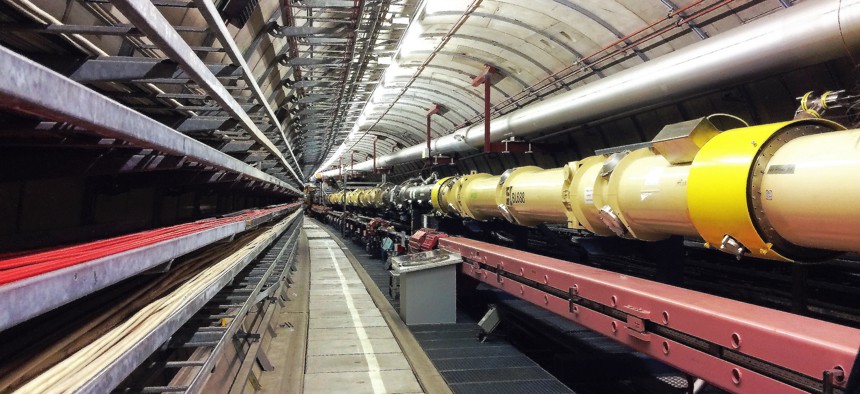THOMAS CORBETT and PETER W. SINGER

The prototype “particle beam cannon” recently completed by Chinese Academy of Sciences’ Institute of Modern Physics may sound like science fiction, but it is a novel new technology that promises to recycle dangerous waste produced by a nuclear reactor. A product of China’s huge investment in advanced nuclear-energy systems, the breakthrough could move the country toward energy independence and further cement its global leadership in climate-friendly technology.
In a typical fission reactor, atoms of heavy isotopes such as uranium-235 are broken apart, releasing energy. The process also releases extra neutrons, which collide with other atoms and break them apart in a chain reaction. The broken atoms are spent fuel that is cooled for a few years and then carefully stored for a few centuries. But a proposed new type of reactor built with this “cannon”—formally, a proton accelerator—could recycle this spent fuel, making it cheaper and safer to generate electricity.
As envisioned, an accelerator-driven system, or ADS, consists of three parts: the proton accelerator launches protons, the spallation target contains the heavy element to be split, and the sub-critical reactor contains the fuel which causes fission. The accelerator fires protons at a heavy element (most likely bismuth) surrounded by a blanket of spent fuel and fresh fissile material (most likely thorium-232 or uranium-238). The target splits apart, releasing neutrons that are absorbed by the spent fuel, turning it back into fissile heavy isotopes—that is, fresh nuclear fuel. Importantly, this process is self-terminating, and does not run the risk of a chain reaction or a meltdown. The Institute of Modern Physics’ completion of a prototype accelerator is a big step toward a working ADS, and a prime example of China’s huge investment in advanced nuclear energy systems paying dividends in new innovations.
Unlike numerous governments that have abandoned nuclear energy entirely, China sees fission as key to a more secure future. Nuclear power is more efficient than wind or solar, and unlike fossil fuels, it does not emit greenhouse gases and particulate air pollution. Ranked second in the world for daily oil consumption, China’s inexorable demand for ever more energy places it in a precarious position. Upwards of 70% of China’s petroleum comes from imports, primarily from the Middle East, and must transit numerous maritime chokepoints. China is slated to spend $440 billion between now and 2035 to build at least 150 more nuclear reactors. If China can continue to develop ADS technology, the waste from these plants can be put to good use and be recycled to produce even more energy for its growing needs.
Beijing is also aiming to reduce the possibility of radiological leaks and uncontrolled chain reactions by developing new and inherently safer systems. While the Fukushima and Chernobyl nuclear disasters are the most famous examples of what can go wrong, China too faced its own issues in June of 2021 when the Taishan nuclear power plant in Guangdong Province had a possible radiation leak from failed fuel rods. China plans to spend nearly $10 billion on a new generation of ocean-bound floating nuclear power plants, while also exploring nuclear fusion as a safer alternative to fission.
China is outspending the United States in the nuclear sphere. Since 2009, the Department of Energy has awarded less than $900 million to improve nuclear infrastructure and resilience. It was major news, by the standards of the U.S. nuclear community, when the DOE announced an additional $48.8 million for the Nuclear Energy University Program, including $24 million for fuel-cycle research and development. There may be additional money for nuclear projects in the DOE’s $20 billion Office of Clean Energy Demonstrations, intended to innovate new energy sources.
Currently, two new plants are being built in the United States, the Vogtle Units 3 & 4 near Waynesboro, Georgia, while another, the NuScale reactor, is still in the planning phase. Before this, the most recent nuclear plants in the United States opened in 1996 and 2016, respectively. At the same time, 21 nuclear reactors are currently being decommissioned in the United States. Although improving technology has kept nuclear energy’s share of the country’s electricity at around 20 percent, the current outlook for the U.S. 2050 energy portfolio shows a marked decline in nuclear’s share.
China’s work on its particle-beam accelerator and ADS is of importance to the country’s industry, its energy strategy, and its global leadership in a wider range of issues, from technology to climate change. If the United States continues to invest in innovation, such new options and techniques may become viable for it as well. Most experts agree that advanced sources of nuclear energy enabled by approaches like ADS are far safer than their predecessors and could prove critical to the world meeting its climate goals in the coming decades. While China is certainly racing towards a goal of energy leadership, that doesn’t mean it is the only one that can benefit.
No comments:
Post a Comment